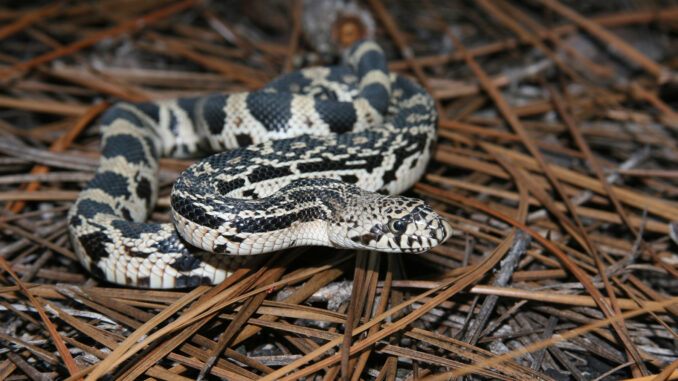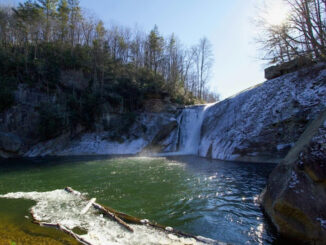
Biologists with the N.C. Wildlife Resources Commission are asking the public to help them learn more about the distribution of the northern pine snake in western North Carolina by reporting any sightings of snakes in the wild.
Recent reporting efforts have resulted in two new records of pine snakes in Cherokee County, the first in over 10 years in western North Carolina.
Northern pine snakes are large and heavy-bodied, typically reaching between 4four to five feet, but can be as long as seven and a half feet. They have a white, tan, or yellowish background color with dark brown or black markings that begin as heavy mottling on the head and gradually become distinct blotches toward the tail. While their size should make them easy to spot in the wild, northern pine snakes spend most of their time underground and so seeing one is no easy task.
“The best chance of spotting one is during the day, in forest openings, as they forage and move from burrow to burrow,” said Gabrielle Graeter, a wildlife diversity biologist with the Commission. “Although the best time of the year to see one is in the spring and early summer, September and October are also good times since pine snakes are beginning to move to locations where they will spend the winter.”
People who see a pine snake in the wild are asked to email pinesnake@ncwildlife.org with the following information:
- A photo (required)
- Date and time the snake was observed
- The location (GPS coordinates are best, but a detailed location description is acceptable)
Those who need help identifying snakes can visit the Herps of North Carolina website, which provides snake identification tips as well as photos on all 38 snake species native to the state. People who find other snake species are asked to submit their observations to Herpmapper, an organization that receives “catch and release” data from the general public, reptile and amphibian enthusiasts, other citizen scientists and professionals for research and conservation purposes.
In western North Carolina, pine snakes are found in southwestern mountain counties, with Cherokee and Swain counties having the majority of verified sightings. Pine snakes also are found in the Sandhills and the southern Coastal Plain. They prefer open areas within pine-oak forests with well-drained and sandy soils.
To get a better understanding of pine snake populations in Cherokee and Swain counties, the Commission is working with the U.S. Forest Service and Eastern Band of Cherokee Indians to conduct surveys in areas where pine snakes have either been seen or in areas with potentially suitable habitat. The Commission has constructed camera traps, which can document snakes passing through the area.
Graeter cautions people to look but not touch any pine snakes they come across in the wild. While the pine snake is neither dangerous nor venomous, it is protected in North Carolina.
Biologists believe pine snakes are declining throughout much of their range and because of this, they are state listed as a threatened species and cannot be collected or taken from the wild without a permit issued by the Commission’s Executive Director.
For more information on pine snakes in North Carolina, read the Commission’s Northern Pine Snake Wildlife Profile.






















